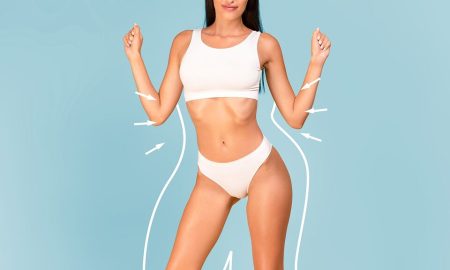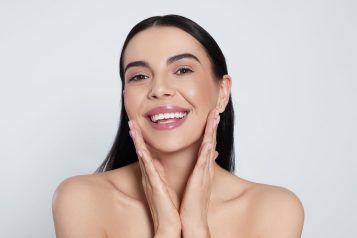Breast augmentation is a very common cosmetic procedure, but you might not be aware of all your options when deciding on the implant type. Here, Dr. Samuel Lin, the renowned plastic surgeon of Boston Plastic Surgery, teams up with Dr. Hassan Alnaeem to discuss with Haute Beauty the types of implants and how to make the best decision for your surgery.

Haute Beauty: What are the two types of breast implants?
Dr. Samuel Lin: Smooth surface and textured surface.
HB: What happens if I have textured breast implants?
SL: The FDA has recommended routine monitoring. They do not recommend the removal or exchange of the textured implant.
HB: What are the symptoms of textured implant-associated lymphoma (ALCL)?
SL: Generally a recurrent fluid collection around the implant and/or possible fullness or a mass surrounding the implant.
HB: What are the main companies that manufacture breast silicone implants?
SL: Breast augmentation surgery is the most common aesthetic surgery in the world. There have been 313,735 breast augmentation procedures performed in 2018 in the United States. Three companies distribute breast implants; Allergan Inc. (Dublin, Ireland), Mentor Inc. (Irvine, California) and Sientra Inc. (Santa Barbara, California).
HB: What are the types of silicone implants?
SL: Breast implants have evolved over time since the 1960s. Currently available and FDA approved implants in the market are the fourth- and fifth-generation breast implants. The fourth-generation implants are called cohesive implants but they are still fluid-filled implants as they are not cohesive enough to maintain the anatomical shape. On the other hand, the fifth-generation implants are called highly cohesive implants or “Gummy Bear” implants as they maintain the shape creating more upper pole fullness in breast augmentation patients. This doesn’t mean that the fifth- generation is better as it tends to have a firmer and less natural feel than fourth-generation breast implants.
HB: What about the shape of the implants?
SL: Given the high cohesivity of the fifth-generation “Gummy Bear” breast implants; there are two kinds of the fifth-generation breast implants available in the market. Round shaped breast implants and anatomical shaped “tear drop” breast implants.
HB: Does the surface of the implant differ between round and anatomical (teardrop) silicone breast implants?
SL: Yes, the round implant has a smooth surface as the rotation of the implant is uneventful while the anatomical shaped implant has a textured surface to stabilize the implant in place as the rotation of the anatomical shaped implant will yield a deformed breast.
HB: Does the texturing process of the implant surface vary among manufacturing companies?
SL: Sientra (Santa Barbara, California) named its texturing process as True texturing, Allergan (Dublin, Ireland) named its texturing process as BIOCELL texturing while Mentor (Santa Barbara, California) SILTEX texturing is created by a process called imprint stamping. Each company process implant texturing in a different way.
HB: Are there any major complications of textured surface breast implants?
SL: Recently, breast implant-associated anaplastic large cell lymphoma (ALCL) has been linked to textured surface breast implants. This may be related to an increase in the surface area when textured implants are used but the exact cause is unknown. A recent article using Australian and New Zealand data suggests an implant specific risk ratio of 1/3,817 for BIOCELL textured implant and 1/60,631 for SILTEX textured implants.
HB: Are there drawbacks to a smooth implant?
SL: Generally speaking no, however, anecdotally some plastic surgeons feel that smooth implants may exhibit more ‘rippling’ or visibility through the skin versus a shaped anatomic implant. However, there are newer ‘overfilled’ smooth-surfaced implants that may help to counter that effect.
References:
- Maxwell GP, Gabriel A. The evolution of breast implants. Plast Reconstr Surg. 2014;134(1 Suppl):12S-17S.
- In: CADTH Canadian Drug Expert Committee Recommendation: Ulipristal Acetate (Fibristal - Allergan Inc.): Indication: Uterine fibroids. Ottawa (ON)2017.
- Barr S, Hill E, Bayat A. Current implant surface technology: an examination of their nanostructure and their influence on fibroblast alignment and biocompatibility. Eplasty. 2009;9:e22.
- Stevens WG, Harrington J, Alizadeh K, et al. Five-year follow-up data from the U.S. clinical trial for Sientra's U.S. Food and Drug Administration-approved Silimed(R) brand round and shaped implants with high-strength silicone gel. Plast Reconstr Surg. 2012;130(5):973-981.
- Rastogi P, Riordan E, Moon D, Deva AK. Theories of Etiopathogenesis of Breast Implant-Associated Anaplastic Large Cell Lymphoma. Plast Reconstr Surg. 2019;143(3S A Review of Breast Implant-Associated Anaplastic Large Cell Lymphoma):23S-29S.
- Loch-Wilkinson A, Beath KJ, Knight RJW, et al. Breast Implant-Associated Anaplastic Large Cell Lymphoma in Australia and New Zealand: High-Surface-Area Textured Implants Are Associated with Increased Risk. Plast Reconstr Surg. 2017;140(4):645-654.























